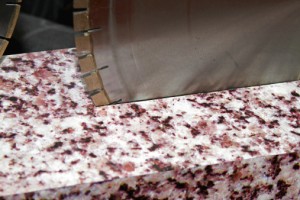Silica Hazards from Engineered Stone Countertops
Posted on byA new engineered stone countertop product known as “quartz surfacing,” was created in the late 1980s by combining quartz aggregate with resins to create a product for use in home building and home improvement. Manufacturing of this material, including products such as CaesarStone™, Silestone™, Zodiaq™, or Cambria™ is a fast growing industry. First made in Israel and Spain, production of these materials has grown world-wide, driving quartz slab imports to the U.S. up 63% between 2011 and 2012 and 48% between April 2012 and April 2013 (Schwartzkopf 2013, StatWatch 2013). Quartz surfacing materials may contain up to 93% crystalline silica (Dupont 2010). In contrast, the percent of crystalline silica in a slab of granite is less than 45%, darker color granite has a lower percentage (Simcox et al. 1999). Workers who fabricate and install quartz surfacing are at risk for overexposure to silica released during sizing, cutting, grinding and polishing. Prolonged inhalation of dust from silica-containing materials can lead to silicosis (scarring of the lungs). In addition to silicosis, scientific evidence indicates that occupational exposure to crystalline silica puts workers at increased risk for other serious health conditions: chronic obstructive lung disease, lung cancer, kidney and connective tissue disease, and tuberculosis. The focus of this blog is on silicosis, which has occurred in multiple workers in this industry.
Silicosis
Silicosis is caused by breathing in very fine (“respirable”) dust containing crystalline silica. Initially, individuals may be developing disease even without respiratory symptoms. Chronic silicosis typically develops over 10 or more years of exposure to low levels of respirable crystalline silica. However, high levels of exposure can cause faster development of the disease. The diagnosis is usually made through a chest radiograph, which should be classified by a NIOSH-certified Reader.
Cases of silicosis have been reported among engineered stone countertop workers in other countries. In a study published in 2012, researchers in Israel found 25 patients referred to their National Lung Transplantation Program with silicosis who shared a common exposure history. All had worked with the same commercial brand of decorative quartz surfacing material for 10–14 years and performed similar dry-cutting of the material for kitchens and other countertop applications (Kramer et al. 2012). Most recently, 46 cases of silicosis were reported in Spain in workers cutting and installing engineered stone countertops with silica content of 70-90% (Pérez-Alonso et al. 2014). These individuals were young (ages 29–37 years) and worked in the industry for 9–17 years.
While no reported cases of silicosis in the U.S. have been linked to quartz surfacing materials, recent research indicates that exposures to silica-containing dust while working with these materials may approach or exceed the Occupational Safety and Health Administration (OSHA) current Permissible Exposure Limit (PEL) (Phillips et al. 2013). Multiple inspections by OSHA (U.S. Department of Labor) have documented overexposures to silica at stone fabrication shops working with a combination of natural stone and quartz surfacing materials (OSHA 2011). These overexposures would indicate U.S. workers in this industry are at risk of developing silicosis as well as the other multiple health conditions associated with silica exposure.
Protecting Workers
We can apply what we know about reducing exposure to dusts from natural stone products to quartz surfacing materials. The key to prevention is keeping dust out of the air. Hazard alerts published in California and Washington State described exposure to silica dust and other hazards related to fabrication of granite and natural stone products and provided dust control recommendations. Whenever possible, cutting, grinding and shaping should be done wet. Ventilation and filtration systems should be used to collect silica-containing dust at its source. If these engineering controls fail to eliminate the risk, then use of at least a NIOSH-approved N95 respirator is recommended.
In addition to information and resources on silica and silicosis for employers and employees provided by NIOSH and OSHA, the Center for Construction Research and Training’s website “Work Safely with Silica” is searchable by work task, material and tool.
Help Wanted
There is relatively little sampling data available on quartz surfacing materials. NIOSH encourages fabricators to submit a request for a Health Hazard Evaluation (HHE). More information can be found on the HHE Topic Page. Researchers at NIOSH are especially interested in seeing a state-of-the-art engineered stone countertop manufacturing facility to help us understand how to best control exposures to quartz surfacing material. If you are interested in working with NIOSH, you can contact us using the comment section below or submit an HHE at the link provided above.
Finally, if individuals working with countertops have health problems or are concerned about past exposures, they should see a healthcare provider and inform them about their concerns. Healthcare providers who suspect that their patients’ health problems may be caused by working with quartz-containing materials are encouraged to report their concern to their state health department.
Web Pages of Interest
- NIOSH Silica Topic Page
- NIOSH Engineering Controls for silica in Construction
- NIOSH Occupational Respiratory Disease Surveillance
- OSHA Silica, Crystalline
- CPWR Work Safely with Silica
- NJ Department of Health and Senior Services Silicosis Surveillance
- MSU Occupational & Environmental Medicine, Silicosis
References
Click here for the references used in this blog entry.
Karen Worthington, MS, RN, COHN-S; Margaret Filios, M.Sc.; RN; Mary Jo Reilly, MS; Robert Harrison, MD, MPH; and Kenneth D. Rosenman, MD.
Karen Worthington is a Research Scientist in the New Jersey Department of Health and Senior Services.
Capt. Filios is a Senior Scientist in the NIOSH Division of Respiratory Disease Studies.
Mary Jo Reilly is an Epidemiologist in the Division of Occupational & Environmental Medicine at Michigan State University.
Dr. Harrison is a Professor of Medicine at UC San Francisco and Chief of the Occupational Health Surveillance and Evaluation Program at the California Department of Public Health.
Dr. Rosenman is a Professor of Medicine and Chief of the Division of Occupational and Environmental Medicine at Michigan State University.
Posted on by


